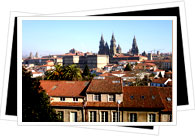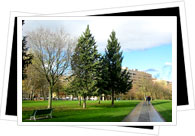Tucked into a valley and surrounded by the lush alpine countryside of the Pyrenees foothills, Pamplona is the historical capital of the Basque Country and the current capital of Navarra, one of Spain's 17 autonomous communities. Pamplona's main sights are dispersed throughout the "old town", which is divided into three parts: La Navarrería, the oldest part of the city, and the 12th-century boroughs of San Cernin and San Nicolás, once vehemently rivaling towns.
 Founded by the Romans, who named it Pompaelo after Pompey the Great, Pamplona passed through the hands of both Visigoths and Muslims before breaking away. By the 8th century, Pamplona had formed a small, fiercely independent nucleus and laid the plans for what would soon become the kingdom of Navarra. Learn more about Pamplona's history.
Founded by the Romans, who named it Pompaelo after Pompey the Great, Pamplona passed through the hands of both Visigoths and Muslims before breaking away. By the 8th century, Pamplona had formed a small, fiercely independent nucleus and laid the plans for what would soon become the kingdom of Navarra. Learn more about Pamplona's history.
 It was Pamplona's situation at the beginning of the Camino de Santiago, however, that ensured the city's development and success. For well over 1,000 years, the faithful have trekked for weeks across Spain to the Galician city of Santiago de Compostela- the Christian world's most visited shrine. Centuries ago, many of Spain's most suceessful and architecture-rich cities were established and flourished thanks to the constant arrival of people, new ideas, etc. Today, the pilgrimage is enjoying great popularity once again and you are bound to see pilgrims donning backpacks, wooden walking sticks and scallop shells around their necks.
It was Pamplona's situation at the beginning of the Camino de Santiago, however, that ensured the city's development and success. For well over 1,000 years, the faithful have trekked for weeks across Spain to the Galician city of Santiago de Compostela- the Christian world's most visited shrine. Centuries ago, many of Spain's most suceessful and architecture-rich cities were established and flourished thanks to the constant arrival of people, new ideas, etc. Today, the pilgrimage is enjoying great popularity once again and you are bound to see pilgrims donning backpacks, wooden walking sticks and scallop shells around their necks.
The heart of the old city is the sprawling Plaza del Castillo, a constant hub of activity surrounded by lovely façades and stylish cafés. The rest of the city center is a dream come true for any wanderer, as it's full of unexpected nooks, wonderful architecture, unique museums and much more. Grab a tasty pintxo in any of the myriad bars, take a peak into the magnificent Gothic cathedral, take advantage of the vibrant nightlife, discover the remaining stretches of Pamplona's formidable defensive walls and much more.
 One of Pamplona's very best aspects is the impressive amount of parks, gardens and other green spaces that make Pamplona one of Europe's "greenest" cities. Head southwest to the edge of the city and you'll find La Ciudadela, a star-shaped citadel built centuries ago to defend Pamplona from invaders. Today, with vast lawns, plenty of benches and walking paths, La Ciudadela is one of the Pamplona's top historical attractions, one of its favorite leisure areas and, with non-stop exhibitions held in the former fortress, one of its cultural hot spots.
One of Pamplona's very best aspects is the impressive amount of parks, gardens and other green spaces that make Pamplona one of Europe's "greenest" cities. Head southwest to the edge of the city and you'll find La Ciudadela, a star-shaped citadel built centuries ago to defend Pamplona from invaders. Today, with vast lawns, plenty of benches and walking paths, La Ciudadela is one of the Pamplona's top historical attractions, one of its favorite leisure areas and, with non-stop exhibitions held in the former fortress, one of its cultural hot spots.
While Pamplona has achieved international notoriety thanks to Ernest Hemingway's fascination with and descriptions of the thrilling Running of the Bulls in his novels, this otherwise tranquil city is without a doubt much more than the edge-of-your-seat, bull dashing frenzy that often seems to define it. The winding streets of the compact city center not only host the clamoring bulls for one week each July, but are also home to plenty of history, architectural treasures, pretty plazas, quaint shops and delightful cafés. Come to Pamplona and discover it all for yourself!